Imagine a healthcare system that is accessible 24/7, provides instant support, and streamlines administrative tasks . This is the future that healthcare chatbot development is helping us to create. These virtual assistants, powered by artificial intelligence (AI) , are poised to revolutionize patient experience and streamline workflows across various healthcare settings.
The healthcare chatbots market, with a valuation of USD 0.2 billion in 2022, is anticipated to witness substantial growth. Projections indicate that the industry will expand from USD 0.24 billion in 2023 to USD 0.99 billion by 2032. This trajectory reflects a robust compound annual growth rate (CAGR) of 19.5% throughout the forecast period from 2023 to 2032 (Source ).

Here are some compelling statistics and facts:
- By geography, the North American region generated more than 60% of the revenue share in 2022
- By deployment, the cloud-based model segment held the largest share, around 75%, in 2022 and was the fastest-growing category from 2023 to 2032.
- By component, the software segment dominates the demand for healthcare chatbots globally.
- By application, the symptoms check segment held the highest market share.
- By end-user, the patient segment is the primary user and holds a significant market share (Source ).
Indeed, chatbot technology in healthcare is the future. The sooner you delve into its capabilities and incorporate them, the better. It is especially relevant in terms of the ongoing consumerization of healthcare.
What makes medical chatbots so worthwhile? To which aspects of chatbot development for the healthcare industry should you pay attention? We're here to respond to such questions.
In this article, you will learn how communication bots can improve the quality of your medical services and get tips on custom healthcare software development . We'll consider the diverse use cases of chatbots in healthcare, highlighting their tangible benefits for patients and medical institutions. We will also explore the key considerations involved in building effective healthcare chatbots.
Key benefits of chatbots in healthcare
Chatbots are improving businesses by offering a multitude of benefits for both users and workers.
According to Outgrow research:
- 88% of users had at least one conversation with a chatbot in 2022
- Using chatbots only resulted in 80% consumer satisfaction because of accurate results
- 64% of businesses trust chatbots to provide personalized customer support
Talking about healthcare, around 52% of patients in the US acquire their health data through healthcare chatbots, and this technology already helps save as much as $3.6 billion in expenses (Source ).
Let's talk about key benefits in more detail.
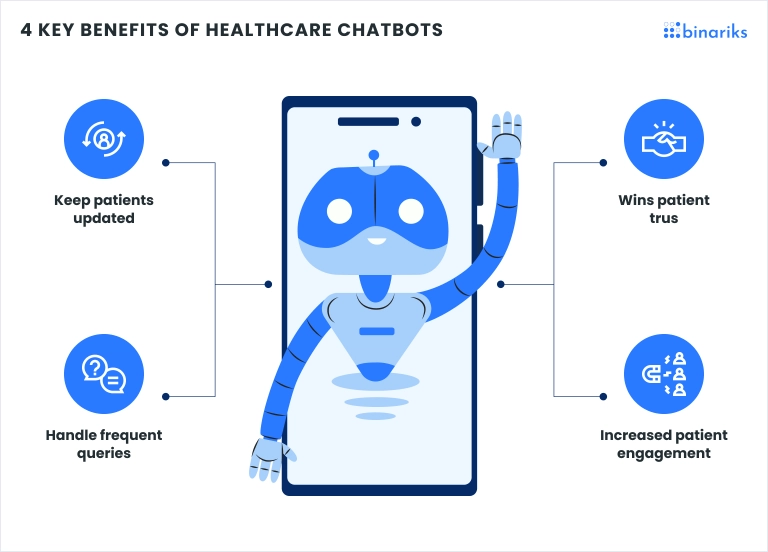
Timely updates and reminders
Chatbots can automatically send appointment reminders, medication refill notifications, and educational content related to specific health conditions, ensuring patients are informed and engaged in their healthcare journey. This also reduces missed appointments and medication non-adherence, ultimately improving health outcomes.
Building trust
Transparency is key. By clearly outlining the chatbot's capabilities and limitations, healthcare institutions build trust with patients. Chatbots can also provide reliable and up-to-date information sourced from credible medical databases, further enhancing patient trust in the information they receive.
Efficient query handling
Chatbots can quickly and efficiently handle a high volume of patient queries, addressing routine questions and concerns and freeing up healthcare professionals to focus on complex cases and direct patient interaction. This improves response times and reduces wait times, leading to a more positive patient experience.
Enhanced engagement
Chatbots provide 24/7 availability, allowing patients to access information and support whenever needed, increasing their engagement with the healthcare system. They can answer basic questions, schedule appointments, and manage tasks, all within the comfortable environment of a digital interface, attracting patients who prefer a self-service approach.
By offering constant availability, personalized engagement, and efficient information access, chatbots contribute significantly to a more positive and trust-based healthcare experience for patients.
Top 5 chatbot use cases in healthcare
1. WHO
The introduction of chatbots has significantly improved healthcare, especially in providing patients with the information they seek. This was particularly evident during the COVID-19 pandemic when the World Health Organization (WHO) deployed a COVID-19 virtual assistant through WhatsApp.
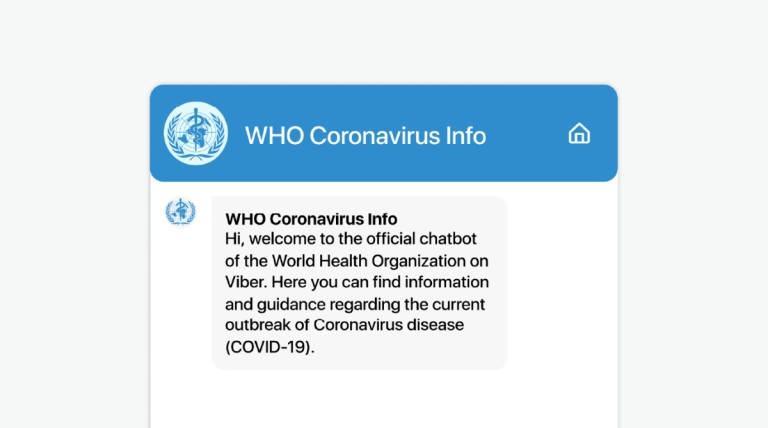
This chatbot efficiently delivered accurate information about the disease, symptoms, treatments, and medications, reaching 13.5 million people in 19 languages. The use of AI technology showcased the adaptability and effectiveness of chatbots in disseminating crucial information during global health crises.
2. Pfizer
AI is proving to be a game-changer for pharmaceutical companies, revolutionizing how they connect with their customers. Through the power of AI , these companies can deliver highly personalized recommendations, tailored content, and pertinent information, creating a more engaging and impactful customer experience.
The applications of AI extend beyond customer interaction to encompass critical areas such as market research, customer segmentation, sentiment analysis, and brand reputation management.

For instance, Pfizer, a prominent player in the pharmaceutical industry, has embraced AI by deploying chatbots like Medibot in the US, Fabi in Brazil, and Maibo in Japan. These chatbots serve as accessible sources of non-technical medicinal information for patients, effectively reducing the workload of call center agents (Source ).
Pfizer's VP, Dominick Albano, underscores the significance of these tools, stating,
"These tools are helping to make it easier for patients to access information along their journey. And as more physicians and patients use smartphones and websites to get medical information, it's meeting them where they're at."
Similarly, ZS Associates employs AI to provide sales analytics and insights, exemplifying AI's multifaceted role in optimizing operations within the pharmaceutical sector. This integration underscores the transformative potential of AI in reshaping customer engagement and operational efficiency for pharmaceutical companies (Source ).
3. Zydus Hospitals
Integrating a chatbot with hospital systems enhances its capabilities, allowing it to showcase available expertise and corresponding doctors through a user-friendly carousel for convenient appointment booking. Utilizing multilingual chatbots further broadens accessibility for appointment scheduling, catering to a diverse demographic.
An example of this implementation is Zydus Hospitals, one of India's largest multispecialty hospital chains, which successfully utilized a multilingual chatbot for appointment scheduling. This approach not only increased overall appointments but also contributed to revenue growth.
The chatbot, recording appointments for all patients, offers additional benefits such as automated reminder notifications and guidance on necessary preparations before appointments. Results speak for themselves: reduced burden on hospital administrators and enhanced reliability due to minimizing errors and providing users with a swift overview of available slots.
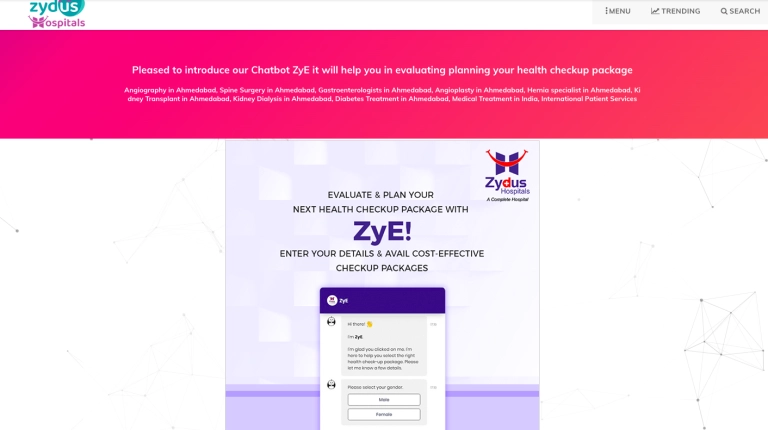
The efficiency of appointment scheduling via chatbots significantly reduces waiting times, enhancing the overall patient experience. In fact, 78% of surveyed physicians consider this application one of the most innovative and practical features of chatbots in healthcare (Source ).
4. Saba Clinics
Healthcare chatbots find valuable application in customer feedback surveys, allowing bots to collect patient feedback post-conversations. This can involve a Customer Satisfaction (CSAT) rating or a detailed system where patients rate their experiences across various services.
Outbound bots offer an additional avenue, reaching out to patients through preferred channels like SMS or WhatsApp at their chosen time. This proactive approach enables patients to share detailed feedback, which is especially beneficial when introducing new doctors or seeking improvement suggestions.
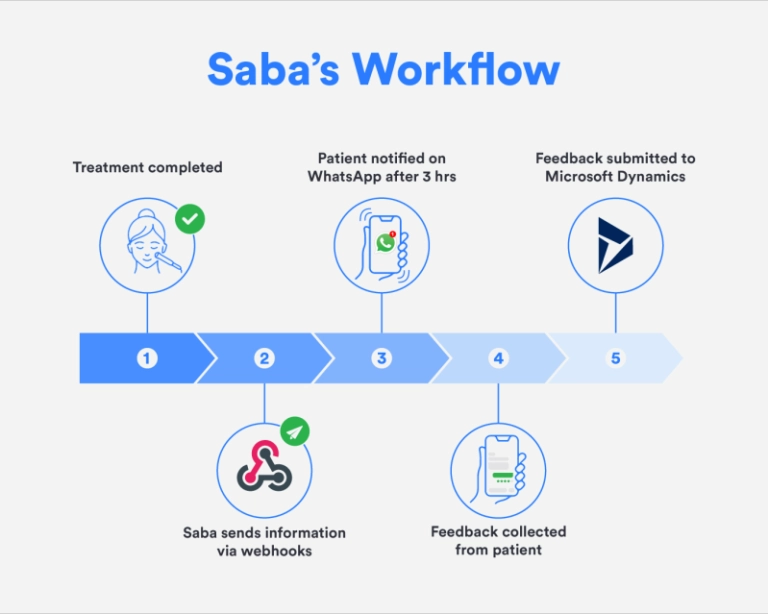
An exemplary case is Saba Clinics, the largest multispecialty skincare and wellness center in Saudi Arabia, which utilized a WhatsApp chatbot to streamline the feedback collection process.
This feedback, encompassing insights on doctors, treatments, and overall patient experiences, has the potential to reshape the perception of healthcare institutions, all facilitated through an automated conversation.
Here are some numbers to show you the impact:
- 85.000 patients engaged so far
- 85% in open rates
- 41% in reply rates
This approach proves instrumental in continuously enhancing services and fostering positive changes within the healthcare environment (Source ).
5. Ministry of Health in Oman
In response to the COVID-19 pandemic, the Ministry of Health in Oman sought an efficient way to provide citizens with accessible and valuable information. To meet this urgent need, an Actionbot was deployed to automate information exchange between healthcare institutions and the public during the pandemic.
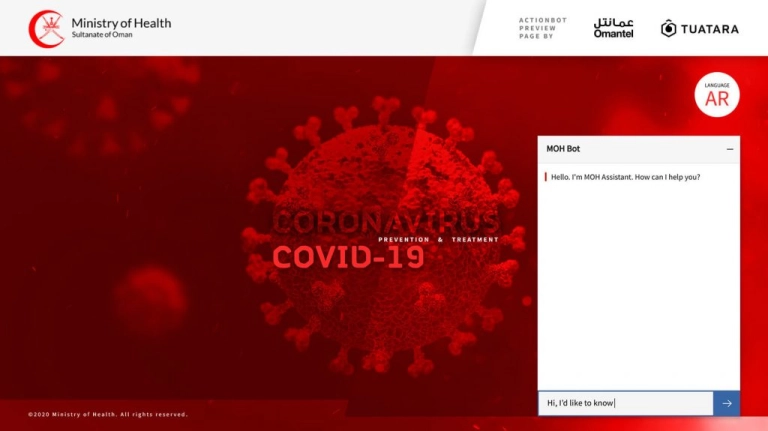
This healthcare bot development played a crucial role in addressing common questions about the virus, disseminating information on necessary safety measures, and providing real-time updates on public COVID-19 statistics.
Tools & platforms for developing healthcare bots
The healthcare chatbot development is vast and ever-evolving. Here are some popular AI platforms and tools well-suited for building healthcare chatbots, along with their key features and considerations:
Microsoft Azure AI Bot Service
Strengths:
- Robust platform offering a comprehensive suite of tools for building, deploying, and managing intelligent chatbots.
- It integrates seamlessly with other Microsoft Azure services like Azure Cognitive Services for advanced AI capabilities (e.g., sentiment analysis and medical language understanding).
- Offers pre-built healthcare bot templates to jumpstart development.
Considerations:
- Requires some technical expertise for development and integration.
Amazon Lex
Strengths:
- Serverless chatbot-building platform by Amazon Web Services (AWS).
- Easy-to-use graphical interface and intuitive drag-and-drop functionality for visual design and flow creation.
- Integrates with other AWS services like Amazon Comprehend Medical for tailored medical language processing.
Considerations:
- It may require additional tools and integrations for complex functionalities.
Google Dialogflow
Strengths:
- Popular platform known for its natural language processing (NLP) capabilities.
- User-friendly interface with pre-built conversation flows and training tools.
- Integrates with Google Cloud services like Google Cloud Healthcare API for accessing healthcare data (adheres to HIPAA compliance ).
Considerations:
- Limited customization options compared to some other platforms.
Rasa Stack
Strengths:
- Open-source platform offering greater control and customization over the chatbot development process.
- Flexible architecture allowing for integration with various NLP tools and libraries.
- Strong community support and extensive documentation.
Considerations:
- It requires more technical expertise and development effort compared to other options.
Choosing the right platform depends on your specific needs and technical capabilities. It's essential to consider factors like:
- Ease of use: How easy is building and managing the chatbot without extensive coding knowledge?
- Features and functionalities: Does the platform offer the necessary features (e.g., HIPAA compliance, medical language processing) for your healthcare use case?
- Scalability: Can the platform handle the expected user volume and future growth?
- Cost: What are the associated costs for using the platform and any additional services required?
It's also recommended to explore additional tools like Chatfuel and ManyChat, which offer user-friendly interfaces for building chatbot experiences, especially for those with limited coding experience. Conducting thorough research and evaluating platforms based on your specific requirements is crucial for choosing the most suitable option for your healthcare chatbot development project.
How to build a medical chatbot step-by-step
This section provides a step-by-step guide to building your medical chatbot, outlining the crucial steps and considerations at each stage. Following these steps and carefully evaluating your specific needs, you can create a valuable tool for your company .
| Steps | Key Points |
| 1. Define your goals | Clearly identify the purpose and functionalities of your chatbot for the specific healthcare context. |
| 2. Choose a development platform | Select a platform that aligns with your technical expertise, budget, and desired features (e.g., HIPAA compliance). |
| 3. Design the conversation flow | Map out the chatbot's dialogue structure, including user prompts, responses, and branching paths. |
| 4. Train the chatbot | Provide the chatbot with training data (e.g., healthcare knowledge base, user dialogues) to enable accurate and relevant responses. |
| 5. Test and refine | Thoroughly test the chatbot's functionality, identify any issues, and iterate on the training data and conversation flow for continuous improvement. |
| 6. Deploy and monitor | Launch the chatbot on your chosen platform and monitor its performance, gathering user feedback for further optimization. |
Best practices for healthcare chatbot development
To create a chatbot for healthcare purposes, you must understand that it goes beyond simply providing information. It requires careful planning, security measures, and a user-centric approach. Here are some essential tips to consider:
1. Prioritize security and compliance
- HIPAA compliance: Healthcare chatbots often handle sensitive patient data. Ensure your chatbot adheres to HIPAA regulations by avoiding third-party texting platforms and focusing on secure web development technologies. Consider using AWS HIPAA-compliant solutions or similar options.
- Data security measures: Implement secure APIs , fortified servers, and a robust firewall to prevent information leaks. Employ user authorization, 2-factor authentication, and end-to-end data encryption for maximum security.
2. Choose the right chatbot technology
- Rule-based vs. AI-driven: Each type has its advantages.
- Rule-Based (Decision Tree): Predetermined responses for common questions, ideal for structured interactions and reliable performance.
- AI-Driven (Machine Learning): Learns and adapts over time, handling complex questions and offering natural language interaction.
- Choosing the Right Option: There's no one-size-fits-all answer. Consider your budget, user interaction complexity, and desired customization level.
3. Craft an engaging conversational style
- User-centric design: Research healthcare chatbot use cases and tailor the chatbot's voice to your target audience.
- Engaging personality: Start conversations with welcoming messages and maintain a polite, informative tone throughout.
- Data-driven responses: Equip the chatbot with relevant information to answer user questions comprehensively.
4. Offer human support
- Backup for complex inquiries: Acknowledge that even advanced chatbots may encounter unforeseen situations.
- Seamless handover: Avoid automatic redirection to human agents. Instead, provide a clear "contact support" option that becomes available only when the chatbot struggles to assist the user.
5. Invest in customization
- Limited features with pre-built solutions: While readily available chatbot builders offer ease of use, their functionalities might be insufficient for complex healthcare needs.
- Benefits of custom development: Tailored functionality that meets your unique needs, scalability to accommodate future growth and evolving needs, and integration with existing systems for a seamless experience.
You can build a secure, effective, and user-friendly healthcare chatbot by carefully considering these key points. Remember, the journey doesn't end at launch; continuous monitoring and improvement based on user feedback are crucial for sustained success.
Creating chatbots for healthcare with Binariks
Now that you have a solid understanding of healthcare chatbots and their crucial aspects, it's time to explore their potential! If navigating the intricacies of chatbot development for healthcare seems daunting, consider collaborating with experienced software engineering teams.
Here's where Binariks comes in. Our experience developing Angular-based solutions has helped organizations across various industries, including healthcare, achieve remarkable results.
Ready to take your healthcare consumer experience to the next level? Our portfolio showcases the depth of our expertise. Contact us today to discuss your vision and explore how custom chatbots can transform your business.
Don't let technical limitations hinder your progress. Harness the full potential of healthcare chatbots and create a more engaging and efficient experience for your patients and healthcare professionals.
FAQ
Share

